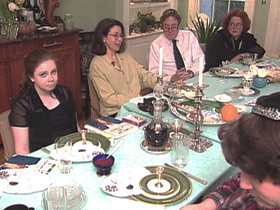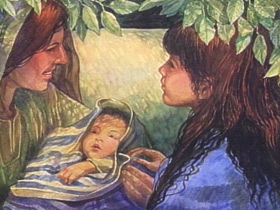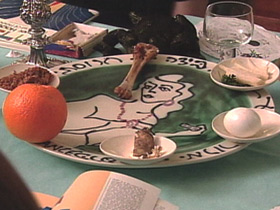In This Episode << SLIDE LEFT TO SEE ADDITIONAL SEGMENTS
Women’s Passover
BOB ABERNETHY: Jews around the world are just concluding the eight days of Passover. At the Seder table on the first two nights, they read from a guide called the Haggadah, which tells the story of the Jews’ exodus from Egypt. Left out of the traditional account, we’re told, is the story of Miriam, Moses’ sister. Rabbi Judith Halevy of the Malibu Jewish Center and Synagogue in California is our storyteller, updating the familiar tale. And Susan Weidman Schneider, editor of LILITH magazine, invited us to her Passover Seder to help tell the women’s story.

Rabbi JUDITH HALEVY (Malibu Jewish Center and Synagogue): Passover says to us, in every generation, you are commanded to tell the story of your own exodus to your children. Now is the moment that women are beginning to tell their story.
SUSAN WEIDMAN SCHNEIDER (Editor, LILITH Magazine): That when we change things a little bit, like the wording and the language, the job of everybody is to, not to roll your eyes. The job of everybody is to be appreciative of the changes.
Rabbi HALEVY: So, on a personal level, I begin to tell my own story to my children. I begin to ask the story of my mother and my grandmother. No one ever told these stories.
Ms. SCHNEIDER: We have a little pot, it now has flowers in it, which comes from Grandma’s house, our grandmother’s house, it was for a little “boil up an egg for the child” pot.
Rabbi HALEVY: You sit at a table, and you share your stories. This is our road trip for the Jewish people.

Ms. SCHNEIDER: Also, from our grandmother who came from Russia at the turn of the century, some little silver cups that we use only at Passover time.
Rabbi HALEVY: Inherent in the original story, however, is very much a woman’s story, and it hasn’t been edited out of Torah. It’s right there. It’s just not the piece we choose to emphasize in the telling. The story of Miriam, however, is the key story. She is the older sister. Whoever did the editing took Miriam out along the way. And the Midrash tells us that men separated from their wives because they didn’t want to have babies who would just be drowned. And Miriam brings her family back together again and convinces her parents in Midrash to remarry, and so that they can have this baby, and of course, Moses is born. The Midrash tells us that she foresaw who her brother was going to be, and that’s why she’s called the prophetess. When we get to the crossing of the sea, Miriam is obviously powerful.

She leads the women in song and dance — her timbrels, her drums and tambourines and joyous occasion. And there’s a song of Moses and a song of Miriam.
Ms. SCHNEIDER: So, let’s sing one round of it for Miriam.
Rabbi HALEVY: The power she must have had over women, to be the one who brought joy and dance, and we are the inheritors of that from Miriam. As we sit and tell the tale, we expand that tale now.
Unidentified Woman #1: What is that?
Unidentified Woman #2: It’s an orange.
Rabbi HALEVY: Of course, we now put an orange on the Seder plate. It comes from the story that about 15 years ago, someone said, “Well, a woman has no more place on the bima than an orange on a Seder plate.” So, we’ve got oranges on the Seder plate, and a lot of women are on the bima lately. And that’s a lot of oranges.

